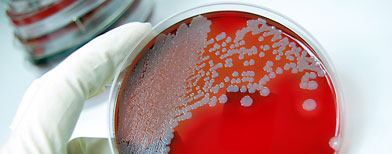Scarlet fever—the much-feared scourge of the past—is back, with an outbreak in Hong Kong that has killed two children and sickened hundreds. More than 21,000 cases have also been reported in China so far this year, nearly quadruple the rate for the same period in 2010, while infections have tripled in Macau, prompting the Centers for Disease Control (CDC) to issue a warning to travelers to China, Hong Kong, and Macau.


What makes the outbreak particularly alarming is that the strain infecting the region is 60 percent resistant to antibiotics commonly used to treat it, compared to 10 to 30 percent resistance in previous strains, according to a microbiologist from Hong Kong University, reports the Taipei Times. Officials expect the outbreak to continue over the summer. Just how dangerous is scarlet fever--and does the outbreak pose a threat to Americans? Here’s a closer look at this infectious disease.
What’s behind the reemergence of scarlet fever? Although scarlet fever is no longer as lethal as it was in the 19th century—when it ranked as a leading cause of death in kids—the disease has never fully disappeared. Between 1999 and 2006, there were 9,400 cases of scarlet fever in the US, according to Yahoo! News. Hong Kong scientists who isolated the bacteria in a six-year-old patient found a genetic mutation that may make the new strain more contagious than usual, which could explain the dramatic rise in cases in the affected region.
Is the outbreak likely to spread to the US? So far, there are no reports of any surge in scarlet fever cases in the US. Health authorities warn travelers to Hong Kong, China and Macau to wash their hands frequently and avoid crowded places that lack fresh air to reduce the risk of catching the disease.
What causes scarlet fever? The same bacteria that cause strep throat trigger scarlet fever: Group A streptococcus. In order to cause scarlet fever, the bacteria must produce a certain toxin. It causes a skin reaction, leading to the characteristic bright red rash that gives the disease its name.
The Group A strep bacteria that spark scarlet fever were also the culprits in the 1990 death of Jim Henson, creator of the Muppets, at age 53. Like the child in Hong Kong, he developed toxic shock syndrome, the deadly disorder that struck women who used a certain brand of tampons in the 1980s and developed staphylococcal infections. In Henson's case, the reason for his strep A infection is unknown, but his illness also included pneumonia, one of the complications of scarlet fever. The bacterial infection progressed with such frightening speed that by the time he went to the hospital, antibiotic treatment was administered too late to save his life. Health authorities believe that Group A strep is becoming more potent and strikes more often than in past, the NY Times reports.
How is it spread? The infection is transmitted through airborne droplets released when an infected person coughs or sneezes. You can also catch it by touching surfaces contaminated by the spray and sharing beverages, food, or eating utensils with an infected person. In rare cases, scarlet fever can be spread by contaminated food, Medscape reports. The incubation period is 12 hours to 7 days and people with the disease can infect others before the symptoms show up.
What are the symptoms? The hallmark of scarlet fever is a sunburn-like rash with tiny red bumps that makes the skin feel rough, like sandpaper. The patient’s tongue often resembles a strawberry--red and bumpy—or may have a whitish coating. Other symptoms include a fever of 101 or higher, a red, sore throat that makes swallowing painful, swollen glands, and less commonly, vomiting or belly pain. After the rash fades, skin on the fingertips and toes may peel.
Who is at risk? Although anyone can get scarlet fever, it is most likely to strike school-age children, according to the CDC. All of the reported Hong Kong cases have occurred in kids. People who have been exposed to the bacteria in the past are usually immune. Medscape reports that about 80 percent of people over the age of 10 have developed lifelong protective antibodies against the disease.
How serious is scarlet fever? If treated promptly, it usually clears up without any serious complications. However, if it goes untreated, the bacteria can spread to the tonsils, sinuses, skin, ears, and blood. More serious cases can lead to pneumonia, middle ear infections, rheumatic fever, kidney disease, arthritis, and toxic shock, the condition that killed one of the children in the Hong Kong outbreak.
What is the treatment? Scarlet fever is treated with antibiotics, rest and fluids. Although the Hong Kong strain is resistant to some of the antibiotics used to treat the disease, penicillin still works. Antibiotic resistant bacteria are a growing health threat worldwide, as more and more bacteria are mutated to be resistant to some or all of the common antibiotics, as a result of overuse of these medications.
What are the best ways to prevent scarlet fever? The CDC recommends washing your hands frequently and avoiding sharing eating utensils, linens, towels and other personal items. It’s particularly crucial for anyone with a sore throat to wash his or her hands frequently, to reduce the risk of spreading the bacteria. The germs are most easily transmitted in close quarters, putting family members at risk if there is an infected person in the household. There is no vaccine to prevent scarlet fever or strep throat.
No comments:
Post a Comment